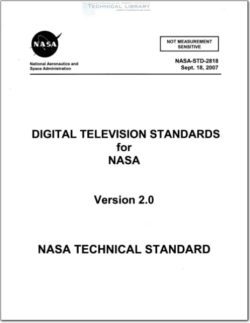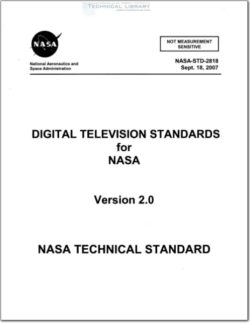NASA-STD-2818

- Version
- 156 Downloads
- 4.23 MB File Size
- 1 File Count
- April 19, 2016 Create Date
- April 19, 2016 Last Updated
Digital Television Standards for NASA

This standard is approved for use by the National Aeronautics and Space Administration
(NASA) Headquarters and all NASA Centers and is intended to provide a common framework
for consistent practices across NASA programs.
This standard was developed by the NASA Digital Television Working Group (DTVWG) and by
the NASA Office of the Chief Information Officer, Architecture and Operations Division, to assist
the development and implementation of Digital Television (DTV) systems that support the
Agency.
Since the 19805, the technology and equipment used for the acquisition, contribution,
production, and distribution of television has been moving from the traditional world of analog
signals, recording formats, and signal processing into the digital realm. Digital video systems,
starting with cameras and recorders for image acquisition, through systems for program
contribution and production, to final signal distribution are now in use in most television
facilities. The commencement of commercial terrestrial DTV broadcasting in 1998 signified the
general availability of end-to-end DTV capability in the United States.
The US. standard for terrestrial DTV broadcasting established by the Federal Communications
Commission (FCC) is based on work recorded in document A/53, prepared by the Advanced
Television Systems Committee (ATSC). In addition to specifying a method for broadcasting a
digital representation of the traditional U.S. 525-line interlace scan television format, the ATSC
A/53 document detailed many new television formats and variations for both Standard and High
Definition Television (SDTV and HDTV). Although the FCC adopted most aspects of the ATSC
recommendations when it established the standard for US. DTV broadcasting, it declined to
specify the use of any particular picture format or formats. However, the formats listed in table 3
of the ATSC A/53 document are generally accepted in the television industry as the formats to
be used for broadcasting. The result of this action has been that instead of just one format of
television for all uses, there are now many different available types and levels of quality of DTV.
During the era of a single analog U.S. standard video signal format, American National
Standards Institute (ANSI)/Society of Motion Picture and Television Engineers (SMPTE) 170M-
1994, there has been no real need for NASA to develop Agency—wide television signal stan-
dards. The fact that there are so many new and different picture formats and signal processing
methods now available has shown the reason for NASA to establish standards for DTV. These
standards are needed so that there may be common methods developed for the acquisition and
production of DTV information and for the distribution and interchange of DTV signals and video
products both within and external to the Agency.
| File | Action |
|---|---|
| NASA-STD-2818 Digital Television Standards for NASA.pdf | Download |
Comment On This Post